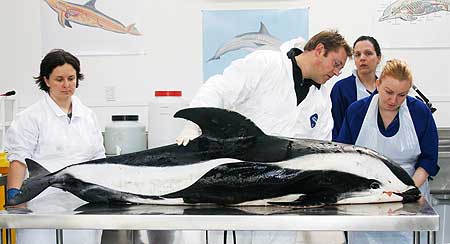The elusive hourglass dolphin

Bec Crew
Bec Crew

NAMED FOR THE distinct white shape along its sides, the hourglass dolphin (Lagenorhynchus cruciger) is found throughout the cold open waters of the Southern Ocean, never straying anywhere warmer than about 13°C.
Rarely seen since its discovery almost 200 years ago, the hourglass dolphin is said to be the only cetacean – a large group of marine mammals that includes whales, dolphins, and porpoises – to have been classified based on eyewitness accounts alone.
In fact, it was declared a new species by French naval surgeons and naturalists, Jean René Constant Quoy and Joseph Paul Gaimard, using nothing but a sketch made as they ran an expedition to the Antarctic in 1824. Fortunately though, with markings as distinct as the hourglass dolphin’s, you’re not likely to misidentify one.
Today, as few as six whole skeletons have been discovered of this incredible-looking mammal. The most recent was the result of a beaching off the coast of New Zealand in 2010 – the first hourglass dolphin to wash up on their shores in 150 years. And that’s saying something, because New Zealand is where these elusive creatures are most commonly sighted.
“For a long time it was only known from sea observations, and so the carcass here represents one of just a handful of fresh, complete, specimens that anyone has had a chance to investigate,” the Te Papa National Museum’s Marine Mammals Collection Manager, Anton Van Helden, said at the time.

Researchers look over an hourglass dolphin that washed up on the shores of
New Zealand in 2010. (Credit: Massey University / Wikimedia)
Hourglass dolphins a small, rare species
Hourglass dolphins are so adorably small, stretching just 1.8 metres in length and weighing no more than 120 kilograms. It’s suspected that the males are actually smaller than the females, but no one has the data to know for sure.
They’ve got short, stubby beaks, a white underbelly, and a perfectly hooked dorsal fin. They’re thought to congregate in pods of up to 100 individuals, splitting off into schools of around seven.
While ‘rarely sighted’ often means ‘few left’ these days, estimates have put their global population at around 140,000 individuals. They’re so little known, that poachers have so far left them alone, and it’s thought their only predators are orcas, so there are no concerns for the longevity of this beautiful species right now.
I just hope they stay hidden – it sure is working for them.




